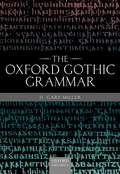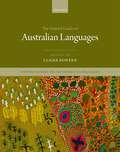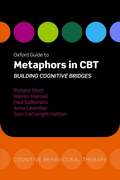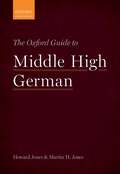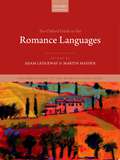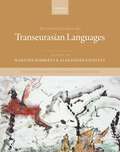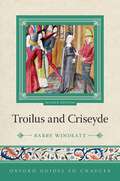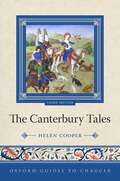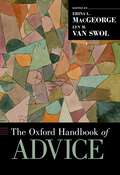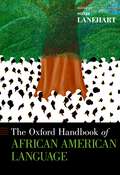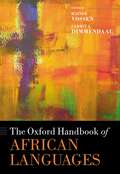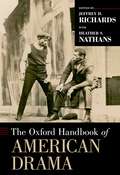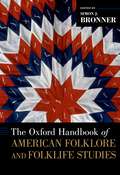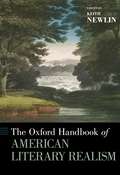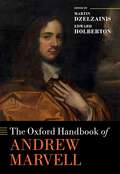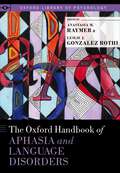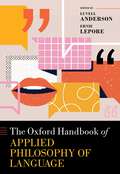- Table View
- List View
The Oxford Gothic Grammar
by D. Gary MillerThis volume provides a comprehensive reference grammar of Gothic, the earliest attested language of the Germanic family (apart from runic inscriptions), dating to the fourth century. The bulk of the extant Gothic corpus is a translation of the Bible, of which only a portion remains, and which has been the focus of most previous works. This book is the first in English to also draw on the recently discovered Bologna fragment and Crimean graffiti, original Gothic texts that provide more insights into the language. Following an overview of the history of the Goths and the origin of the Gothic language, Gary Miller explores all the major topics in Gothic grammar, beginning with the alphabet and phonology, and proceeding through subjects such as case functions, prepositions and particles, compounding, derivation, and verbal and sentential syntax. He also presents a selection of Gothic texts with notes and vocabulary, and ends with a chapter on linearization, including an overview of Gothic in its Germanic context. The Oxford Gothic Grammar will be an invaluable reference for all Indo-Europeanists, Germanic scholars, and historical linguists, from advanced undergraduate level upwards.
The Oxford Guide to Australian Languages (Oxford Guides to the World's Languages)
The Oxford Guide to Australian Languages is a wide-ranging reference work that explores the more than 550 traditional and new Indigenous languages of Australia. Australian languages have long played an important role in diachronic and synchronic linguistics and are a vital testing ground for linguistic theory. Until now, however, there has been no comprehensive and accessible guide to the their vast linguistic diversity. This volume fills that gap, bringing together leading scholars and junior researchers to provide an up-to-date guide to all aspects of the languages of Australia. The chapters in the book explore typology, documentation, and classification; linguistic structures from phonology to pragmatics and discourse; sociolinguistics and language variation; and language in the community. The final part offers grammatical sketches of a selection of languages, sub-groups, and families. At a time when the number of living Australian languages is significantly reduced even compared to twenty year ago, this volume establishes priorities for future linguistic research and contributes to the language expansion and revitalization efforts that are underway.
Oxford Guide To Metaphors In Cbt: Building Cognitive Bridges (pdf) (Oxford Guides In Cognitive Behavioural Therapy Ser.)
by Richard Stott Warren Mansell Paul Salkovskis Anna Lavender Sam Cartwright-HattonThe business of cognitive therapy is to transform meanings. What better way to achieve this than through a metaphor? Metaphors straddle two different domains at once, providing a conceptual bridge from a problematic interpretation to a fresh new perspective that can cast one's experiences in a new light. Even the simplest metaphor can be used again and again with different clients, yet still achieve the desired effect. One such example is the 'broken leg' metaphor for depression. Clients with depression are understandably frustrated with their symptoms. They may often push themselves to get better or tell themselves that they should be better by now. As a therapist, it is fair to ask, would the client be so harsh and demanding on herself after getting a broken leg? A broken leg needs time to heal and you need to begin to walk on it gradually as it builds up in strength. "You can't run before you can walk" and if you try, you are likely to make it worse. For many clients this simple metaphor is enlightening, changing their view of their symptoms as a sign of their own laziness and worthlessness, to a view of them as part of an understandable illness, that while open to improvement, cannot get better over night. This book is the first to show just how metaphors can be used productively in CBT as an integral part of the treatment. It describes the use of metaphors for a wide range of problems, including anxiety and depression, and provides countless examples of metaphors that have been used by others in CBT. It brings together in one place hundreds of metaphors that experienced therapists have used to great success. It will be a valuable sourcebook for all cognitive behaviour therapists, as well as those training in CBT.
The Oxford Guide to Middle High German
by Howard Jones Martin H. JonesThe Oxford Guide to Middle High German is the most comprehensive self-contained treatment of Middle High German available in English. It covers the language, literature, history, and culture of German in the period from 1050 to 1350 and is designed for entry-level readers, advanced study, teaching, and reference. The book includes a large sample of texts, not only from Classical works such as Erec, the Nibelungenlied, Parzival, and Tristan, but also from mystical writing, chronicles, and legal documents; the selection represents all major dialects and the full time span of the period. The volume begins with an introduction that defines Middle High German linguistically, geographically, and chronologically. Chapter 2 then provides a detailed exploration of the grammar, covering sounds and spelling, inflectional morphology, syntax, and lexis. Each section in this chapter begins with a summary of the main points, followed by detailed paragraphs for in-depth study and reference. Chapter 3 deals with versification, discussing metre, rhyme, lines of verse in context, and verse forms, and includes practical tips for scansion. Chapter 4 offers an account of the political and social structures of Medieval Germany and a survey of the principal types of texts that originated in the period. The final chapter of the book comprises over forty texts, each placed in context and provided with explanatory footnotes; the first two texts, to be taken together with the introductory grammar sections, are aimed at newcomers. A glossary provides full coverage of the vocabulary appearing in the texts and throughout the book.
The Oxford Guide to the Romance Languages (Oxford Guides to the World's Languages)
The Oxford Guide to the Romance Languages is the most exhaustive treatment of the Romance languages available today. Leading international scholars adopt a variety of theoretical frameworks and approaches to offer a detailed structural examination of all the individual Romance varieties and Romance-speaking areas, including standard, non-standard, dialectal, and regional varieties of the Old and New Worlds. The book also offers a comprehensive comparative account of major topics, issues, and case studies across different areas of the grammar of the Romance languages. The volume is organized into 10 thematic parts: Parts 1 and 2 deal with the making of the Romance languages and their typology and classification, respectively; Part 3 is devoted to individual structural overviews of Romance languages, dialects, and linguistic areas, while Part 4 provides comparative overviews of Romance phonology, morphology, syntax, semantics and pragmatics, and sociolinguistics. Chapters in Parts 5-9 examine issues in Romance phonology, morphology, syntax, syntax and semantics, and pragmatics and discourse, respectively, while the final part contains case studies of topics in the nominal group, verbal group, and the clause. The book will be an essential resource for both Romance specialists and everyone with an interest in Indo-European and comparative linguistics.
The Oxford Guide to the Transeurasian Languages (Oxford Guides to the World's Languages)
The Oxford Guide to the Transeurasian Languages provides a comprehensive account of the Transeurasian languages, and is the first major reference work in the field since 1965. The term 'Transeurasian' refers to a large group of geographically adjacent languages that includes five uncontroversial linguistic families: Japonic, Koreanic, Tungusic, Mongolic, and Turkic. The historical connection between these languages, however, constitutes one of the most debated issues in historical comparative linguistics. In the present book, a team of leading international scholars in the field take a balanced approach to this controversy, integrating different theoretical frameworks, combining both functional and formal linguistics, and showing that genealogical and areal approaches are in fact compatible with one another. The volume is divided into five parts. Part I deals with the historical sources and periodization of the Transeurasian languages and their classification and typology. In Part II, chapters provide individual structural overviews of the Transeurasian languages and the linguistic subgroups that they belong to, while Part III explores Transeurasian phonology, morphology, syntax, lexis, and semantics from a comparative perspective. Part IV offers a range of areal and genealogical explanations for the correlations observed in the preceding parts. Finally, Part V combines archaeological, genetic, and anthropological perspectives on the identity of speakers of Transeurasian languages. The Oxford Guide to the Transeurasian Languages will be an indispensable resource for specialists in Japonic, Koreanic, Tungusic, Mongolic, and Turkic languages and for anyone with an interest in Transeurasian and comparative linguistics more broadly.
Oxford Guides to Chaucer: Troilus And Criseyde (Oxford Guides to Chaucer)
by Prof Barry WindeattThis is a comprehensive critical guide to Chaucer's Troilus and Criseyde. This new edition has been comprehensively revised in light of the latest scholarly and critical research and with a fully updated bibliography. It includes a full account of Chaucer's imaginative deployment of his sources, and an extended survey of this narrative poem's innovative combination of a range of generic identities. The chapters explain how Chaucer builds thematic significance into his poem's symmetrical structure, and the poem's distinctive variety in style and language, as well as a full commentary on the poem's concerns with love in the contexts of time and mutability and human free will. The Guide explores the poem as an extended debate about the nature and value of love, and how love was conceptualized and experienced as a form of service in quest of compassionate reward, a quasi-religious devotion, and a potentially fatal illness always in hope of cure. The subjectivities of the chief protagonists are fully analysed, as is the poem's problematic ending. Alongside discussions of theme and structure, there is also an account of what the extant manuscripts of Troilus and Criseyde may reveal about the poem's early genesis, and a unique survey of responses to Troilus from its own times to the present day. Barry Windeatt's contribution to the series is a comprehensive single-volume guide to Troilus and Criseyde, bringing together a wide range of material and providing a readable commentary on all aspects of the work. Combining the informative substance of a reference book with the coherence of a critical reading, the Guide has taken its place as the standard introduction to Troilus and Criseyde since its first publication in 1992.
Oxford Guides to Chaucer: The Canterbury Tales (Oxford Guides to Chaucer)
by Prof Helen CooperRecognised on its first appearance as the most comprehensive single-volume guide to The Canterbury Tales yet produced, this third edition brings the Tales up to date in relation both to recent criticism and to the changing expectations of modern readers. The Guide provide tale-by-tale information on textual variations and sources, together with a readable commentary on thematic issues, structure, style, generic affiliations, and the contribution of each tale to the work as a whole. It concludes with a survey of the many imitations of the tales down to the early seventeenth century. This new edition also takes account of the latest scholarship, theory, and criticism and new interpretations of the tales, including such matters as gender identity, consent, and racial and religious difference. The book is the most comprehensive single-volume guide to the Tales yet produced, bringing together a wide range of disparate material and providing a readable commentary on all aspects of the work. It combines the comprehensive coverage of a reference book with the clarity and coherence of a critical account. Since its first publication in 1989, the Guide has established itself as an indispensable aid for any reader looking to develop their understanding of The Canterbury Tales.
Oxford Guides to Chaucer: The Canterbury Tales (Oxford Guides to Chaucer)
by Prof Helen CooperRecognised on its first appearance as the most comprehensive single-volume guide to The Canterbury Tales yet produced, this third edition brings the Tales up to date in relation both to recent criticism and to the changing expectations of modern readers. The Guide provide tale-by-tale information on textual variations and sources, together with a readable commentary on thematic issues, structure, style, generic affiliations, and the contribution of each tale to the work as a whole. It concludes with a survey of the many imitations of the tales down to the early seventeenth century. This new edition also takes account of the latest scholarship, theory, and criticism and new interpretations of the tales, including such matters as gender identity, consent, and racial and religious difference. The book is the most comprehensive single-volume guide to the Tales yet produced, bringing together a wide range of disparate material and providing a readable commentary on all aspects of the work. It combines the comprehensive coverage of a reference book with the clarity and coherence of a critical account. Since its first publication in 1989, the Guide has established itself as an indispensable aid for any reader looking to develop their understanding of The Canterbury Tales.
Oxford Guides to Chaucer: Troilus and Criseyde (Oxford Guides to Chaucer)
by Prof Barry WindeattThis is a comprehensive critical guide to Chaucer's Troilus and Criseyde. This new edition has been comprehensively revised in light of the latest scholarly and critical research and with a fully updated bibliography. It includes a full account of Chaucer's imaginative deployment of his sources, and an extended survey of this narrative poem's innovative combination of a range of generic identities. The chapters explain how Chaucer builds thematic significance into his poem's symmetrical structure, and the poem's distinctive variety in style and language, as well as a full commentary on the poem's concerns with love in the contexts of time and mutability and human free will. The Guide explores the poem as an extended debate about the nature and value of love, and how love was conceptualized and experienced as a form of service in quest of compassionate reward, a quasi-religious devotion, and a potentially fatal illness always in hope of cure. The subjectivities of the chief protagonists are fully analysed, as is the poem's problematic ending. Alongside discussions of theme and structure, there is also an account of what the extant manuscripts of Troilus and Criseyde may reveal about the poem's early genesis, and a unique survey of responses to Troilus from its own times to the present day. Barry Windeatt's contribution to the series is a comprehensive single-volume guide to Troilus and Criseyde, bringing together a wide range of material and providing a readable commentary on all aspects of the work. Combining the informative substance of a reference book with the coherence of a critical reading, the Guide has taken its place as the standard introduction to Troilus and Criseyde since its first publication in 1992.
The Oxford Handbook of Advice (Oxford Handbooks)
by Erina L. MacGeorge and Lyn M. Van SwolAdvice, defined as a recommendation for action in response to a problem, is a common form of interpersonal support and influence. Indeed, the advice we give and receive from others can be highly consequential, not only affecting us as recipients and advisors, but shaping outcomes for relationships, groups, and organizations. Some of those consequences are positive, as when advice promotes individual problem-solving, or enhances workgroup productivity. Yet advice can also hide ulterior motives, threaten identity, damage relationships, and promote inappropriate action. The Oxford Handbook of Advice provides a broad perspective on how advice succeeds and fails, systematically reviewing and synthesizing theory and research on advice from multiple disciplines, such as communication, psychology, applied linguistics, business, law, and medicine. Several chapters explore advice at different levels of analysis, focusing on advisor and recipient roles, advising interactions and relationships, and advice as a resource and connection in groups and networks. Other chapters address advice in particular types of personal relationships (romantic, family) and professional contexts (workplace, health, education, therapy). Contributing authors also consider cultural differences, advice online, and the ethics of advising. For scholars concerned with supportive communication, interpersonal influence, decision-making, social networks, and related communication processes at work, at home, and in society at large, this Handbook offers historical perspective, contemporary theoretical framing, methodological recommendations, and directions for future research. It also emphasizes practical application, offering clear, concise, and relevant "advice for advising" based on theory and research.
The Oxford Handbook of Advice (Oxford Handbooks)
Advice, defined as a recommendation for action in response to a problem, is a common form of interpersonal support and influence. Indeed, the advice we give and receive from others can be highly consequential, not only affecting us as recipients and advisors, but shaping outcomes for relationships, groups, and organizations. Some of those consequences are positive, as when advice promotes individual problem-solving, or enhances workgroup productivity. Yet advice can also hide ulterior motives, threaten identity, damage relationships, and promote inappropriate action. The Oxford Handbook of Advice provides a broad perspective on how advice succeeds and fails, systematically reviewing and synthesizing theory and research on advice from multiple disciplines, such as communication, psychology, applied linguistics, business, law, and medicine. Several chapters explore advice at different levels of analysis, focusing on advisor and recipient roles, advising interactions and relationships, and advice as a resource and connection in groups and networks. Other chapters address advice in particular types of personal relationships (romantic, family) and professional contexts (workplace, health, education, therapy). Contributing authors also consider cultural differences, advice online, and the ethics of advising. For scholars concerned with supportive communication, interpersonal influence, decision-making, social networks, and related communication processes at work, at home, and in society at large, this Handbook offers historical perspective, contemporary theoretical framing, methodological recommendations, and directions for future research. It also emphasizes practical application, offering clear, concise, and relevant "advice for advising" based on theory and research.
The Oxford Handbook of African American Language (Oxford Handbooks)
by Sonja LanehartThe goal of The Oxford Handbook of African American Language is to provide readers with a wide range of analyses of both traditional and contemporary work on language use in African American communities in a broad collective. The Handbook offers a survey of language and its uses in African American communities from a wide range of contexts organized into seven sections: Origins and Historical Perspectives; Lects and Variation; Structure and Description; Child Language Acquisition and Development; Education; Language in Society; and Language and Identity. It is a handbook of research on African American Language (AAL) and, as such, provides a variety of scholarly perspectives that may not align with each other -- as is indicative of most scholarly research. The chapters in this book "interact" with one another as contributors frequently refer the reader to further elaboration on and references to related issues and connect their own research to related topics in other chapters within their own sections and the handbook more generally to create dialogue about AAL, thus affirming the need for collaborative thinking about the issues in AAL research. Though the Handbook does not and cannot include every area of research, it is meant to provide suggestions for future work on lesser-studied areas (e.g., variation/heterogeneity in regional, social, and ethnic communities) by highlighting a need for collaborative perspectives and innovative thinking while reasserting the need for better research and communication in areas thought to be resolved.
The Oxford Handbook of African Languages (Oxford Handbooks)
by Rainer Vossen Gerrit J. DimmendaalThis book provides a comprehensive overview of current research in African languages, drawing on insights from anthropological linguistics, typology, historical and comparative linguistics, and sociolinguistics. Africa is believed to host at least one third of the world's languages, usually classified into four phyla - Niger-Congo, Afro-Asiatic, Nilo-Saharan, and Khoisan - which are then subdivided into further families and subgroupings. This volume explores all aspects of research in the field, beginning with chapters that cover the major domains of grammar and comparative approaches. Later parts provide overviews of the phyla and subfamilies, alongside grammatical sketches of eighteen representative African languages of diverse genetic affiliation. The volume additionally explores multiple other topics relating to African languages and linguistics, with a particular focus on extralinguistic issues: language, cognition, and culture, including colour terminology and conversation analysis; language and society, including language contact and endangerment; language and history; and language and orature. This wide-ranging handbook will be a valuable reference for scholars and students in all areas of African linguistics and anthropology, and for anyone interested in descriptive, documentary, typological, and comparative linguistics.
The Oxford Handbook of African Languages (Oxford Handbooks)
This book provides a comprehensive overview of current research in African languages, drawing on insights from anthropological linguistics, typology, historical and comparative linguistics, and sociolinguistics. Africa is believed to host at least one third of the world's languages, usually classified into four phyla - Niger-Congo, Afro-Asiatic, Nilo-Saharan, and Khoisan - which are then subdivided into further families and subgroupings. This volume explores all aspects of research in the field, beginning with chapters that cover the major domains of grammar and comparative approaches. Later parts provide overviews of the phyla and subfamilies, alongside grammatical sketches of eighteen representative African languages of diverse genetic affiliation. The volume additionally explores multiple other topics relating to African languages and linguistics, with a particular focus on extralinguistic issues: language, cognition, and culture, including colour terminology and conversation analysis; language and society, including language contact and endangerment; language and history; and language and orature. This wide-ranging handbook will be a valuable reference for scholars and students in all areas of African linguistics and anthropology, and for anyone interested in descriptive, documentary, typological, and comparative linguistics.
The Oxford Handbook of American Drama (Oxford Handbooks)
When one thinks of American Drama, names like Eugene O'Neill, Arthur Miller, and Tennessee Williams readily come to mind. However, as The Oxford Handbook of American Drama shows, the U.S. has a deep and varied tradition that extends back to the years before the Revolutionary War. The essays gathered here trace U.S dramatic history, ranging from plays by Mercy Otis Warren to Tony Kushner. The volume opens with an exploration of the trials and tribulations of strolling players in the colonial era, before shifting to a discussion of the ways plays were deployed for political ends during the Revolution, most notably by the patriot Mercy Otis Warren. The narrative extends to the post-Revolutionary period when plays were used as vehicles to promote republican virtue. Contributors also explore the vibrant drama to emerge during the nineteenth century, when blackface performers and stars such as Edwin Forrest, Charlotte Cushman, and Edwin Booth dominated the stage. The period also witnessed the arrival of the first piece of musical theater, The Black Crook, which is productively situated in a musical tradition that extends to Rodgers and Hammerstein. The Handbook offers a complex treatment of melodrama - the most popular genre of the century. The volume traces the rise of the country's first black acting company in the 1820s, as well as the growing number of ethnic characters presented on the stage. Several of the contributors also highlight the role of women playwrights such as Anna Cora Mowatt in the development of American drama. At the turn of the twentieth century, the Provincetown Players helped to usher in the era of modern drama, which allowed playwrights such as Eugene O'Neill, Susan Glaspell, and Edna St. Vincent Millay to experiment with the form and attempt topics regarded as taboo at the time. As melodrama gave way to realism, exemplified in the work of O'Neill and Rachel Crothers, other dramatic techniques such as naturalism and expressionism were introduced to the stage. Other topics covered in the Handbook include: the political plays of Arthur Miller; the major freedoms brought to the American stage since the 1960s; the new generation of playwrights, such as Tony Kushner and Harvey Fierstein, who created plays dealing explicitly with topics like AIDS and homosexuality; and the rich genealogy of the African American family play in works by Lorraine Hansberry, August Wilson, and Suzan-Lori Parks. The volume concludes with the bold performance art of the Living Theatre and the new multiculturalism that arrived on the contemporary stage, with various ethnic communities --Mexicans, Puerto Ricans, Asians, and Native Americans-becoming the focus of the action. The Oxford Handbook of American Drama presents a comprehensive introduction to the form in all its guises.
The Oxford Handbook of American Folklore and Folklife Studies (Oxford Handbooks)
by Simon J. BronnerThe Oxford Handbook of American Folklore and Folklife Studies surveys the materials, approaches, concepts, and applications of the field to provide a sweeping guide to American folklore and folklife, culture, history, and society. Forty-three comprehensive and diverse chapters delve into significant themes and methods of folklore and folklife study; established expressions and activities; spheres and locations of folkloric action; and shared cultures and common identities. Beyond the longstanding arenas of academic focus developed throughout the 350-year legacy of folklore and folklife study, contributors at the forefront of the field also explore exciting new areas of attention that have emerged in the twenty-first century such as the Internet, bodylore, folklore of organizations and networks, sexual orientation, neurodiverse identities, and disability groups. Encompassing a wide range of cultural traditions in the United States, from bits of slang in private conversations to massive public demonstrations, ancient beliefs to contemporary viral memes, and a simple handshake greeting to group festivals, these chapters consider the meanings in oral, social, and material genres of dance, ritual, drama, play, speech, song, and story while drawing attention to tradition-centered communities such as the Amish and Hasidim, occupational groups and their workaday worlds, and children and other age groups. Weaving together such varied and manifest traditions, this handbook pays significant attention to the cultural diversity and changing national boundaries that have always been distinctive in the American experience, reflecting on the relative youth of the nation; global connections of customs brought by immigrants; mobility of residents and their relation to an indigenous, urbanized, and racialized population; and a varied landscape and settlement pattern. Edited by leading folklore scholar Simon J. Bronner, this handbook celebrates the extraordinary richness of the American social and cultural fabric, offering a valuable resource not only for scholars and students of American studies, but also for the global study of tradition, folk arts, and cultural practice.
The Oxford Handbook of American Folklore and Folklife Studies (Oxford Handbooks)
by Simon J. BronnerThe Oxford Handbook of American Folklore and Folklife Studies surveys the materials, approaches, concepts, and applications of the field to provide a sweeping guide to American folklore and folklife, culture, history, and society. Forty-three comprehensive and diverse chapters delve into significant themes and methods of folklore and folklife study; established expressions and activities; spheres and locations of folkloric action; and shared cultures and common identities. Beyond the longstanding arenas of academic focus developed throughout the 350-year legacy of folklore and folklife study, contributors at the forefront of the field also explore exciting new areas of attention that have emerged in the twenty-first century such as the Internet, bodylore, folklore of organizations and networks, sexual orientation, neurodiverse identities, and disability groups. Encompassing a wide range of cultural traditions in the United States, from bits of slang in private conversations to massive public demonstrations, ancient beliefs to contemporary viral memes, and a simple handshake greeting to group festivals, these chapters consider the meanings in oral, social, and material genres of dance, ritual, drama, play, speech, song, and story while drawing attention to tradition-centered communities such as the Amish and Hasidim, occupational groups and their workaday worlds, and children and other age groups. Weaving together such varied and manifest traditions, this handbook pays significant attention to the cultural diversity and changing national boundaries that have always been distinctive in the American experience, reflecting on the relative youth of the nation; global connections of customs brought by immigrants; mobility of residents and their relation to an indigenous, urbanized, and racialized population; and a varied landscape and settlement pattern. Edited by leading folklore scholar Simon J. Bronner, this handbook celebrates the extraordinary richness of the American social and cultural fabric, offering a valuable resource not only for scholars and students of American studies, but also for the global study of tradition, folk arts, and cultural practice.
The Oxford Handbook of American Literary Realism (Oxford Handbooks)
by Keith NewlinThe scholarship devoted to American literary realism has long wrestled with problems of definition: is realism a genre, with a particular form, content, and technique? Is it a style, with a distinctive artistic arrangement of words, characters, and description? Or is it a period, usually placed as occurring after the Civil War and concluding somewhere around the onset of World War I? This volume aims to widen the scope of study beyond mere definition, however, by expanding the boundaries of the subject through essays that reconsider and enlarge upon such questions. The Oxford Handbook of American Literary Realism aims to take stock of the scholarly work in the area and map out paths for future directions of study. The Handbook offers 35 vibrant and original essays of new interpretations of the artistic and political challenges of representing life. It is the first book to treat the subject topically and thematically, in wide scope, with essays that draw upon recent scholarship in literary and cultural studies to offer an authoritative and in-depth reassessment of major and minor figures and the contexts that shaped their work. Contributors here tease out the workings of a particular concept through a variety of authors and their cultural contexts. A set of essays explores realism's genesis and its connection to previous and subsequent movements. Others examine the inclusiveness of representation, the circulation of texts, and the aesthetic representation of science, time, space, and the subjects of medicine, the New Woman, and the middle class. Still others trace the connection to other arts--poetry, drama, illustration, photography, painting, and film--and to pedagogic issues in the teaching of realism. As a whole, this volume forges exciting new paths in the study of realism and writers' unending labor to represent life accurately.
The Oxford Handbook of American Literary Realism (Oxford Handbooks)
The scholarship devoted to American literary realism has long wrestled with problems of definition: is realism a genre, with a particular form, content, and technique? Is it a style, with a distinctive artistic arrangement of words, characters, and description? Or is it a period, usually placed as occurring after the Civil War and concluding somewhere around the onset of World War I? This volume aims to widen the scope of study beyond mere definition, however, by expanding the boundaries of the subject through essays that reconsider and enlarge upon such questions. The Oxford Handbook of American Literary Realism aims to take stock of the scholarly work in the area and map out paths for future directions of study. The Handbook offers 35 vibrant and original essays of new interpretations of the artistic and political challenges of representing life. It is the first book to treat the subject topically and thematically, in wide scope, with essays that draw upon recent scholarship in literary and cultural studies to offer an authoritative and in-depth reassessment of major and minor figures and the contexts that shaped their work. Contributors here tease out the workings of a particular concept through a variety of authors and their cultural contexts. A set of essays explores realism's genesis and its connection to previous and subsequent movements. Others examine the inclusiveness of representation, the circulation of texts, and the aesthetic representation of science, time, space, and the subjects of medicine, the New Woman, and the middle class. Still others trace the connection to other arts--poetry, drama, illustration, photography, painting, and film--and to pedagogic issues in the teaching of realism. As a whole, this volume forges exciting new paths in the study of realism and writers' unending labor to represent life accurately.
The Oxford Handbook of Andrew Marvell (Oxford Handbooks)
by Martin Dzelzainis Edward HolbertonThe Oxford Handbook of Andrew Marvell is the most comprehensive and informative collection of essays ever assembled dealing with the life and writings of the poet and politician Andrew Marvell (1621-78). Like his friend and colleague John Milton, Marvell is now seen as a dominant figure in the literary landscape of the mid-seventeenth century, producing a stunning oeuvre of poetry and prose either side of the Restoration. In the 1640s and 1650s he was the author of hypercanonical lyrics like 'To His Coy Mistress' and 'The Garden' as well as three epoch-defining poems about Oliver Cromwell. After 1660 he virtually invented the verse genre of state satire as well as becoming the most influential prose satirist of the day - in the process forging a long-lived reputation as an incorruptible patriot. Although Marvell himself was an intensely private and self-contained character, whose literary, religious, and political commitments are notoriously difficult to discern, the interdisciplinary contributions by an array of experts in the fields of seventeenth-century literature, history, and politics gathered together in the Handbook constitute a decisive step forward in our understanding of him. They offer a fully-rounded account of his life and writings, individual readings of his key works, considerations of his relations with his major contemporaries, and surveys of his rich and varied afterlives. Informed by the wealth of editorial and biographical work on Marvell that has been produced in the last twenty years, the volume is both a conspectus of the state of the art in Marvell studies and the springboard for future research.
The Oxford Handbook of Andrew Marvell (Oxford Handbooks)
The Oxford Handbook of Andrew Marvell is the most comprehensive and informative collection of essays ever assembled dealing with the life and writings of the poet and politician Andrew Marvell (1621-78). Like his friend and colleague John Milton, Marvell is now seen as a dominant figure in the literary landscape of the mid-seventeenth century, producing a stunning oeuvre of poetry and prose either side of the Restoration. In the 1640s and 1650s he was the author of hypercanonical lyrics like 'To His Coy Mistress' and 'The Garden' as well as three epoch-defining poems about Oliver Cromwell. After 1660 he virtually invented the verse genre of state satire as well as becoming the most influential prose satirist of the day - in the process forging a long-lived reputation as an incorruptible patriot. Although Marvell himself was an intensely private and self-contained character, whose literary, religious, and political commitments are notoriously difficult to discern, the interdisciplinary contributions by an array of experts in the fields of seventeenth-century literature, history, and politics gathered together in the Handbook constitute a decisive step forward in our understanding of him. They offer a fully-rounded account of his life and writings, individual readings of his key works, considerations of his relations with his major contemporaries, and surveys of his rich and varied afterlives. Informed by the wealth of editorial and biographical work on Marvell that has been produced in the last twenty years, the volume is both a conspectus of the state of the art in Marvell studies and the springboard for future research.
The Oxford Handbook of Aphasia and Language Disorders (Oxford Library of Psychology)
by Leslie J. Gonzalez Rothi Anastasia M. RaymerWhat is immediately clear when meeting individuals with acquired brain damage is that the patterns of communication impairments vary in remarkable ways among these individuals. Aphasia and related communication disorders, while devastating life events for individuals who acquire brain damage, provide lessons of considerable interest to many clinicians and researchers trying to understand the brain's neurological and psychological complexity and develop methods to facilitate optimum recovery of lost language and communication functions following brain damage. The Oxford Handbook of Aphasia and Language Disorders weaves theoretical and neurological foundations with rational, motivated clinical approaches to assessment, diagnosis, and intervention for aphasia and related communication disorders. The contributing authors, experienced clinicians and scientists with strong backgrounds in neurological and cognitive neuropsychological theories, bridge theory to clinical practice, reviewing the extant literature in each aphasia syndrome while exploring implications for guiding clinical decision-making. Introductory chapters provide historical perspectives on the aphasia syndromes following left hemisphere brain damage, and review aphasia assessment across the decades. The bulk of the Handbook covers aphasia syndromes, with chapters that describe each aphasia syndrome in detail, including behavioral, neural, and cognitive neuropsychological correlates and methods to assess and treat each syndrome. Additional chapters provide insights into acquired reading and writing disorders and social and prosodic communication disorders that follow damage to the right cerebral hemisphere. The final chapters examine neural perspectives on aphasia recovery and principles of neuroplasticity in aphasia treatment. As such, this book integrates neural, cognitive, and clinical perspectives to provide a broad understanding of the complexity of language and impairments that can arise following acquired brain damage, and will be of interest to scholars and clinicians in the speech-language, neuropsychology, and rehabilitation professions.
The Oxford Handbook of Aphasia and Language Disorders (Oxford Library of Psychology)
What is immediately clear when meeting individuals with acquired brain damage is that the patterns of communication impairments vary in remarkable ways among these individuals. Aphasia and related communication disorders, while devastating life events for individuals who acquire brain damage, provide lessons of considerable interest to many clinicians and researchers trying to understand the brain's neurological and psychological complexity and develop methods to facilitate optimum recovery of lost language and communication functions following brain damage. The Oxford Handbook of Aphasia and Language Disorders weaves theoretical and neurological foundations with rational, motivated clinical approaches to assessment, diagnosis, and intervention for aphasia and related communication disorders. The contributing authors, experienced clinicians and scientists with strong backgrounds in neurological and cognitive neuropsychological theories, bridge theory to clinical practice, reviewing the extant literature in each aphasia syndrome while exploring implications for guiding clinical decision-making. Introductory chapters provide historical perspectives on the aphasia syndromes following left hemisphere brain damage, and review aphasia assessment across the decades. The bulk of the Handbook covers aphasia syndromes, with chapters that describe each aphasia syndrome in detail, including behavioral, neural, and cognitive neuropsychological correlates and methods to assess and treat each syndrome. Additional chapters provide insights into acquired reading and writing disorders and social and prosodic communication disorders that follow damage to the right cerebral hemisphere. The final chapters examine neural perspectives on aphasia recovery and principles of neuroplasticity in aphasia treatment. As such, this book integrates neural, cognitive, and clinical perspectives to provide a broad understanding of the complexity of language and impairments that can arise following acquired brain damage, and will be of interest to scholars and clinicians in the speech-language, neuropsychology, and rehabilitation professions.
The Oxford Handbook of Applied Philosophy of Language (Oxford Handbooks)
by Luvell Anderson and Ernie LeporeThis Handbook represents a collective exploration of the emerging field of applied philosophy of language. The volume covers a broad range of areas where philosophy engages with linguistic aspects of our social world, including such hot topics as dehumanizing speech, dogwhistles, taboo language, pornography, appropriation, implicit bias, speech acts, and the ethics of communication. An international line-up of contributors adopt a variety of approaches and methods in their investigation of these linguistic phenomena, drawing on linguistics and the human and social sciences as well as on different philosophical subdisciplines. The aim is to map out fruitful areas of research and to stimulate discussion with thought-provoking essays by leading and emerging philosophers.
